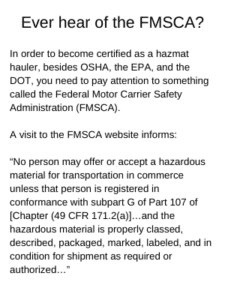Know Your “Cradle to Grave” Responsibilities for Transporting Hazardous Waste
November 18, 2020
Know Your “Cradle to Grave” Responsibilities for Transporting Hazardous Waste
As part of your hazardous waste management and the responsibility of transporting hazardous waste, it’s crucial to choose a reputable, licensed transporter to transit hazmat from your facility to where it will ultimately be disposed of, treated, and/or and stored. Why so?
First and foremost, the Resource Conservation and Recovery Act (RCRA) makes it remarkably easy to be a hazardous waste generator. E.g., the moment you uncork a can of solvent and use it, you’ve joined the ranks. True, you might only generate a single quart of waste solute per week. But the improper storage or disposal of even that small amount can land you squarely in the crosshairs of the EPA, which is not a good place to be. Next, one of the oft-forgotten imperatives of the RCRA is that you’re responsible for any hazardous waste from “cradle-to-grave.” This includes its generation, transportation, treatment, storage, and disposal. Thereby, you’re not only accountable for hazardous waste from the moment it’s generated; you’re also legally responsible for its safe transportation to wherever it will be ultimately processed or disposed of.
Transportation for Hazardous Waste Disposal is Ultimately Your Responsibility—and Liability
As if life weren’t complicated enough per government standards, the training requirements
for hazmat waste removal companies are regulated simultaneously by three different agencies: your
friends at the EPA, those at OSHA, and their counterparts at the federal DOT. There’s also the
FMSCA and the TSA. (See sidebars.)
So who’s actually in charge? Okay, this gets complicated. The Occupational Safety and Health
Act (OSH) states that OSHA doesn’t own jurisdiction over workplace health & safety if
another federal agency exercises statutory authority in this area.
U.S. courts interpret this peculiarity of the OSH Act using a so-called “gap theory” or “hazard-by-
hazard” approach. E.g., if the DOT has a regulation that would reduce or eliminate a workplace hazard, it’s regulations are applicable. If it doesn’t, then OSHA regulations apply.
Think about that: The authority that decides which agency is alpha is “the courts,” which would
suggest that such interpretations are forthcoming after you’ve done something one or the other
the agency doesn’t like, haplessly instigating a litigious dogfight between the two that’s all about you.
As we’re fond of counseling our readers: get expert advice. But ever onward…
How do the EPA and DOT comingle?
In deference to the fact that hazardous waste-removing companies use public roads, highways, rails, and waterways—regulations for container specifications, labeling, marking, and placarding is primarily developed by the DOT, with EPA input.
Concerns primary to the EPA:
- EPA Identification Numbers. The EPA requires all hazmat haulers to have an EPA ID number, which is assigned to a transportation company as a whole rather than requiring each of its trucks to have its own unique ID.
- Hazardous waste manifests. The EPA requires that a manifest accompany the movement of a hazardous waste “cradle to grave.” This manifest indelibly attaches a waste to your enterprise as it migrates from its point of origin to its ultimate destination facility—be it storage, treatment, recycling, or whatever.
- Accidental discharges. Hazmat transport drivers must be properly trained to take immediate action in the event of an accidental hazmat discharge, including but not limited to notifying local authorities and diking the discharge area to protect health and minimize any environmental impact.
Concerns primary to the DOT:
- CDL-Class A. As a first requirement, a hazmat hauler must have an active Commercial Driver’s License (CDL- Class A)—and a safe driving record. If you or your employee haven’t this license already—understand that regulations for its acquisition aren’t consistent from state to state.
- Most states, however, require a learning “permit” period during which a CDL aspirant drives with an experienced CDL holder in the vehicle. In due course, the applicant must pass a driving skills test, usually administered by the state DOT.
- Hazmat-specific training. If a person has an active CDL-Class A, safe driving record, and is 21 years of age or older, he or she is duly qualified to make an application for hazmat certification. Additional requirements include proof of citizenship or legal residence, medical and optometric exams. There is also a TSA background check.
- Hazmat knowledge test. The DOT requires that hazmat drivers be tested for appropriate training in such areas as transit operations between destination points, proper handling of hazardous materials during loading and unloading, safest ways to readjust and re-secure loads while in transit, and more.
The Upshot:
Part of your “cradle-to-grave” hazardous-waste responsibilities is ensuring that the transporter you select for hazardous waste removal (to your preferred disposal, storage, or treatment facility) meets a myriad of DOT requirements. These minimally include specific labeling and “marking” prerequisites; and there are strict rules governing the kinds of containers you can use.
As in all things involving the EPA, it’s a really good idea to get expert advice before lugging a few barrels of whatever down to the local dump in the back of your F-150, and preferably from a national company with wide-ranged expertise relative to hazardous materials disposal, as rules differ among states, cities, and even localities.
Hope to hear from you. And thank you for reading our blog!


